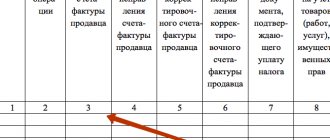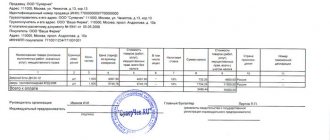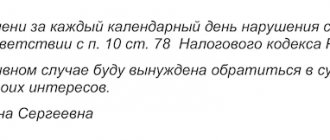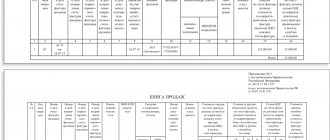Advance payments in the Tax Code
Speaking about VAT and advance payments, it is necessary to take into account the provisions of a number of articles of the Tax Code of the Russian Federation. Article 168, paragraph 1, declares the seller’s obligation to present VAT to the buyer for payment on amounts of prepayment, partial prepayment for goods, works, services, property rights. The tax is calculated according to the rules of Art. 164 clause 4, by calculation method at a rate of 20/120 (in some cases 10/110).
Within five days from the date of receipt of the money, the buyer who has made an advance payment is presented with an invoice (Article 168, paragraph 3). The buyer has the right to accept the amounts presented by the seller for deduction (Article 171, paragraph 12).
If the delivery does not take place: the contract between the parties is terminated or its terms have changed, the advance payment is returned:
- The seller can deduct VAT from partial or full prepayment (Article 171, paragraph 5);
- the buyer is obliged to restore the full amount of the “advance” VAT accepted for deduction in the tax period when the advance was returned from the seller (Article 170, paragraph 3-3).
Novation agreement
Novation is the replacement of an obligation to repay an advance with a loan obligation. It must be remembered that when concluding an agreement on innovation, claims from regulatory authorities are possible. After all, the Ministry of Finance in its Letter dated 04/01/2014 N 03-07-РЗ/14444 expressed the opinion that the seller’s presentation of VAT for deduction in this situation is unlawful, because there is no actual refund of the advance. However, the courts believe that the obligation to return the advance is terminated (clause 1 of Article 414 of the Civil Code of the Russian Federation), since the amount of the advance will later be returned on the basis of the loan agreement, which means that the seller has the right to deduct the amount of VAT previously paid by him (Determination by YOU RF dated January 28, 2008 N 15837/07).
For more information about the arguments, see our material “Can the seller deduct “advance” VAT if an agreement is concluded with the buyer on novation of the debt into a loan obligation?”
VAT deductible: actions and deadlines
Refunding the advance allows the seller to accept previously paid VAT as a deduction. Let us consider, as an example, the option of terminating the contract between the parties.
Obviously, in order to legally carry out a deduction, it is necessary:
- actually terminate the contract under which the advance was made;
- return the transferred amount to the buyer;
- reflect the refund in documents.
Termination of the contract can occur by agreement of the parties, unilaterally (if the buyer refuses the goods, works or services, the seller refuses delivery) or on the terms specified in the document itself at the time of its preparation (for example, delivery dates are indicated, and if violation, the contract becomes invalid).
Before terminating the contract, it is advisable to reconcile settlements with your business partner in order to avoid mistakes when working with VAT. Termination can be formalized by drawing up a corresponding letter, usually with a reconciliation report attached, and receiving a written consent in response. Another way is to draw up an additional agreement to the contract on its termination. Both options are completely equivalent from a legal point of view.
Refund of the advance payment is possible by transfer, in cash from the cash register, to a third party (if the buyer has stated this in writing).
The refund may also take place against settlements under other contracts with the same buyer. So that tax officials do not have grounds to refuse to accept VAT deduction, it is necessary to formalize this fact in a letter to the buyer, notification or other similar document and make sure that it is received. The notification contains detailed information about two contracts: the one that has been advanced and the one for which there is arrears in payment; amounts, including VAT. The offset is reported with reference to Art. 410 of the Civil Code of the Russian Federation - the article allows for offset if there is an application from only one party.
If there is an uncredited balance of the advance, its amount and method of return are indicated. The safest settlement option is an agreement between counterparties or a bilateral act. Judges, as a rule, rule in favor of the organization in such a situation. In general, confirmation of the return of the advance will be payment documents, for example, a bank payment order.
On a note! The return of an advance payment with property is not a reason for refusing to accept VAT for deduction (decision of the Plenum of the Supreme Arbitration Court No. 33 of 05/30/14, paragraph 23).
The seller can exercise the right to deduction no later than a year from the date of return of the advance (Article 172, paragraph 4 of the Tax Code of the Russian Federation), provided that the corresponding adjustment transactions are reflected in the accounting.
Deduction from advances issued
Having received an advance payment, the seller calculates the tax on it, drawing up an invoice and sending 1 copy to the buyer, who, if he wants, can take this amount as a deduction. Conditions for deduction from advances issued:
- the possibility of making an advance payment must be agreed upon in the supply agreement;
- registration of an invoice within 5 days and availability of all details.
Accounting entry for deduction:
Dt 68/2 Kt 76/VA
For significant amounts, deductions significantly reduce the total of the declaration, and in some cases lead to reimbursement from the budget.
Deductions for prepayment of several deliveries are accepted 1 time, but ahead of time and in an amount that is greater than what it would be with separate deductions. Thus, VAT restoration occurs partially and, as a rule, extends over several tax periods.
Deductions for advance payments paid for part of the supply will be made earlier and in full, while VAT recovery is made in part of such amounts and also extends over more than one quarter.
With deductions, the volume of transactions and, as a result, the turnover of documentation always increases.
There is no point in advance deductions when a small amount was transferred, and the transfer and shipment were carried out in one period.
Use of land for purposes other than its intended purpose may result in a fine. How can a disabled person of the second group get land? Step-by-step instructions are here.
How to correctly fill out a zero land tax return? Find out about this by reading our article.
Tax accounting: what to pay attention to
When working with advance payments, you must be careful when filling out invoices. Tax authorities, in particular, pay attention to the correct indication of the tax rate - 10/110 or 20/120, and not 10% and 20%. When making advance payments, VAT calculations are carried out only at estimated rates.
When registering an invoice for an advance payment in the purchase book in case of a return, the seller uses transaction type code 22 (List of codes for transaction types indicated in the purchase book, attached to the Federal Tax Service order No. ММВ-7-3 / [email protected] dated 14/03 /16).
The details of the invoice for the advance payment, a document confirming the return of money to the buyer - usually a payment order (column 7, see letter of the Ministry of Finance No. 03-07-11/16044 dated 24/03/15) are also indicated. In the relevant In the columns you need to indicate the name of your company, INN, KPP, the full amount of the advance, VAT on the advance is only deductible. The tax must correspond to the refund amount (column 16).
The buyer in the same situation is obliged to restore the tax by reflecting the seller’s invoice for the advance payment in the sales book (it was already reflected in the purchase book). Operation type code 21 is used (Federal Tax Service order No. ММВ-7-3/136, appendix).
VAT is not paid
VAT is not paid on advances paid for the supply of goods:
- taxable at a zero rate;
- not taxable;
- sold outside Russian territory;
- the production cycle of which was more than 6 months after receiving partial payment.
In each of these cases, an invoice is not issued, and data on them is not displayed in the VAT declaration, with the exception of goods with a long production cycle (section 7, line 010 of the VAT declaration).
VAT upon return of advance payment to the buyer
The main criterion for the transition period is the rule: regardless of the size of the tax rate accrued on the advance payment (in 2018 - 18%, in 2021 - 20%) for shipments made in 2021, VAT is taken into account in the shipping invoice at the rate of 20%. There are no other innovations regarding VAT on prepayments.
When shipping goods and materials as an advance payment, the seller has the right to reimburse the amount of tax from the budget. But if the contract is terminated or its provisions are revised, and only part of the goods is shipped or the delivery is canceled completely, then the seller is obliged to return the previously received advance payment (or the unused balance). Its return is also associated with a VAT adjustment, since the seller has the right to claim a deduction from the amount of the unused advance payment if the basis for non-fulfillment of obligations was the termination of the contract or a change in its terms. In this case, the supplier issues an adjustment invoice, recording the refund.
The supplier can deduct VAT when returning the advance payment to the buyer on the date of return of the advance payment. VAT is calculated as the amount of the advance received multiplied by the rate that was applied when receiving the advance payment. The fact of a payment return must be reflected in accounting and confirmed by a payment document. You can claim the right to a deduction within one year from the date of return of payment for a failed (or partially failed) transaction. VAT on the return of the advance payment to the buyer in the declaration is reflected on page 120 of section 3.
Transaction type code in the purchase book
The purchase book is maintained quarterly and filled out by the taxpayer for each tax period. When filling it out, it is necessary to take into account Government Decree No. 1137 of 2011.
When returning an advance to a buyer, the seller must record this transaction in the purchase book and make all necessary adjustments in accounting and management reporting related to the return. This fact is reflected in column 7 of the purchase book. Here are the details of the document that confirms the return of this prepayment.
If you want to find out how to solve your particular problem in 2021, please contact us through the online consultant form or call:
The seller is obliged to register the invoice in the purchase book no later than one year after the buyer refuses to supply. This is indicated in paragraph. 2 clause 22 of Appendix 4 to Government Decree No. 1137.
Additionally, the taxpayer should confirm the right to receive a deduction using documents that indicate termination of the contract (for example, an additional agreement or unilateral refusal to fulfill the contract) and the return of money to the buyer.
How can a buyer recover VAT when returning an advance payment?
You must recover VAT from the advance payment made to you by the seller if this advance payment was subsequently returned to you upon termination of the contract or change in its terms (clause 3, clause 3, article 170 of the Tax Code of the Russian Federation). This means that by the amount of the refunded advance you increase your tax base.
You need to restore VAT from the advance payment, which you previously accepted for deduction, in the quarter in which the conditions changed or the contract was terminated and the advance was returned (clause 3, clause 3, article 170 of the Tax Code of the Russian Federation).
If the advance was partially returned to you, then you need to restore VAT only in the corresponding part.
The purpose of maintaining a purchase ledger is to determine the amount of VAT that is subject to deduction. In it, buyers must register invoices issued by sellers, received on paper and electronic media.
It contains primary invoices, as well as adjustment and corrected invoices.
Notifying the bank about erroneous receipt of funds
A company that has received an erroneous payment must send a written notification to the bank within 10 days of receiving the bank account statement showing the excess funds. The form of such a written message to the bank is not established by law, therefore banks establish such forms with their own internal documents. If the bank does not have an approved form, the organization draws up a message in free form.
Bank, depending on the terms of the bank account agreement:
- if it is possible to write off erroneously credited amounts from the company’s bank account without acceptance, writes off the erroneously credited funds without a separate order from the organization;
- If there is no such possibility under the agreement between the bank and the organization, the erroneously transferred funds are written off only upon receipt of the corresponding order.
nds_pri_vozvrate_avansa_pokupatelyu.jpg
Related publications
The changes that have occurred with the increase in the VAT rate since the beginning of 2021 have raised many questions regarding settlements between counterparties working with this tax. Let's figure out how to correctly document transactions related to the return of the transferred advance payment to the buyer.








